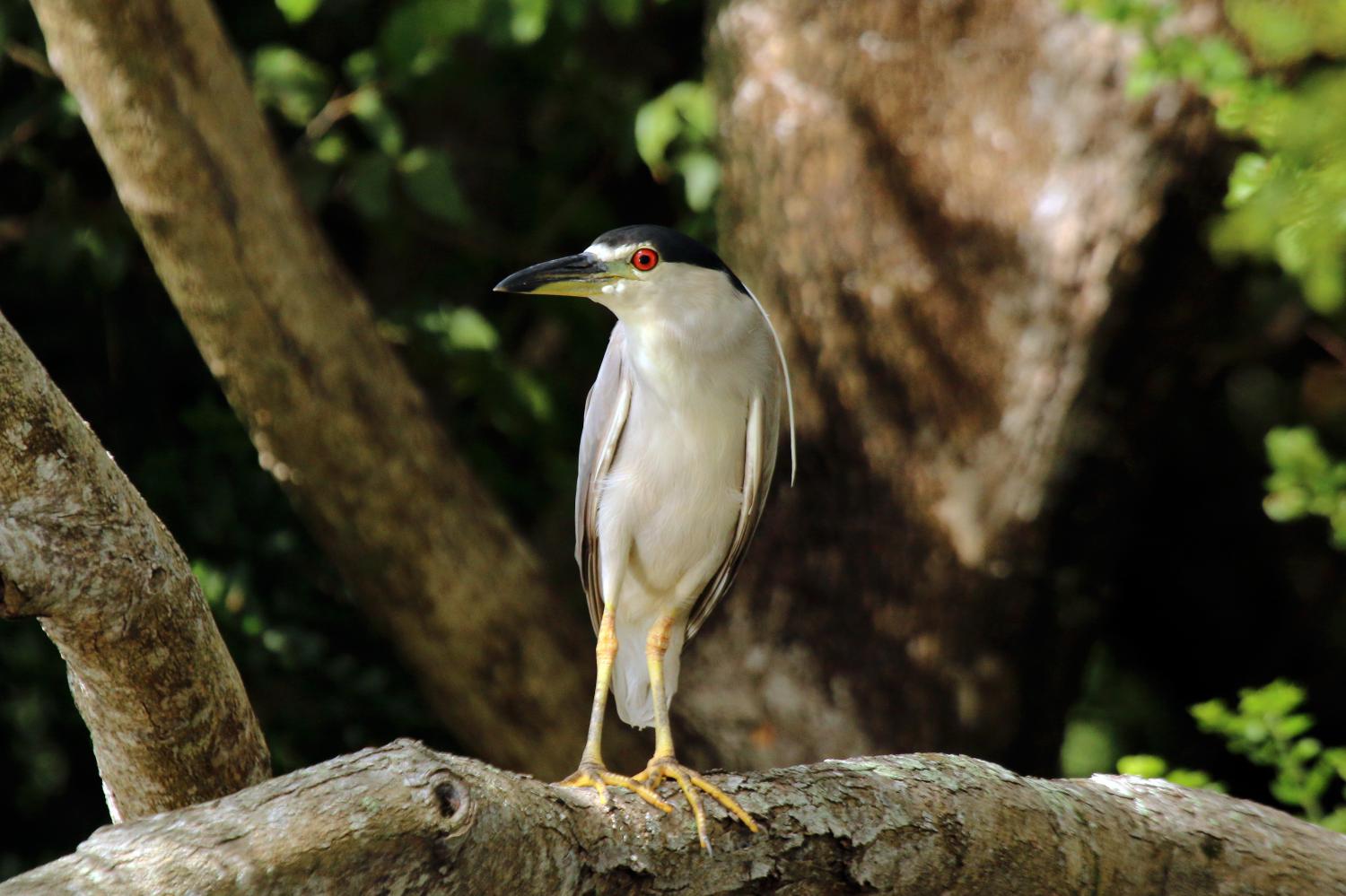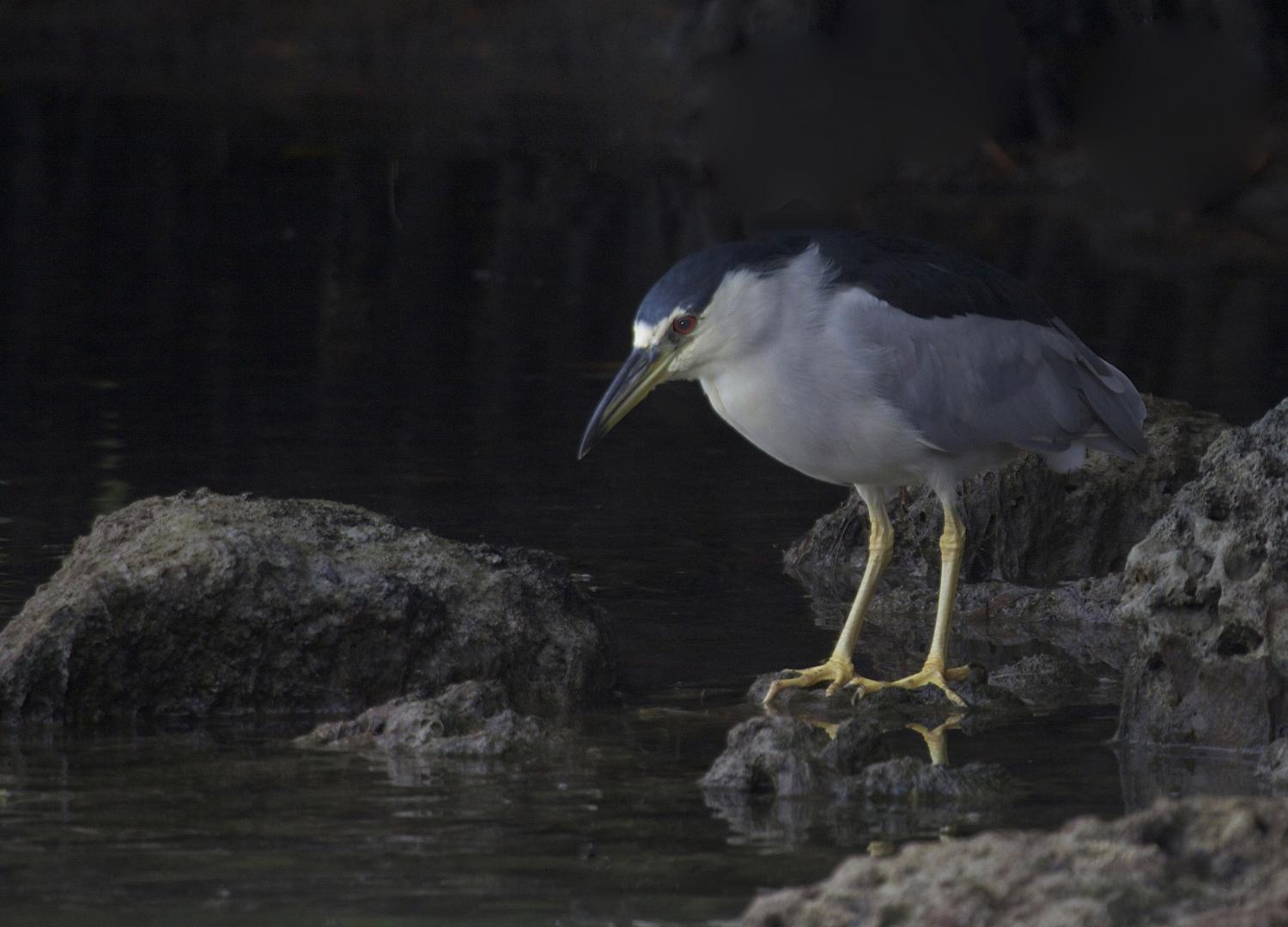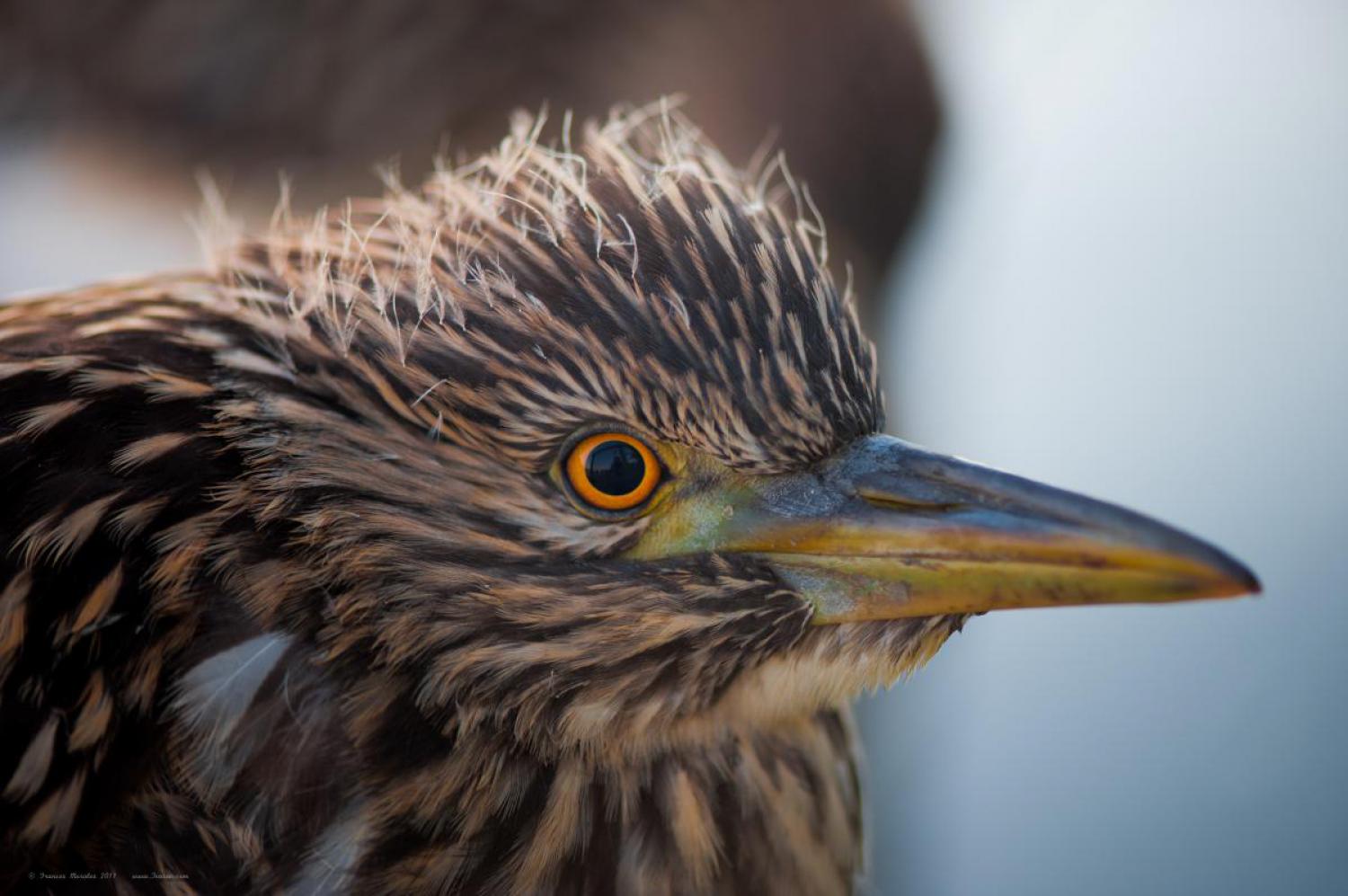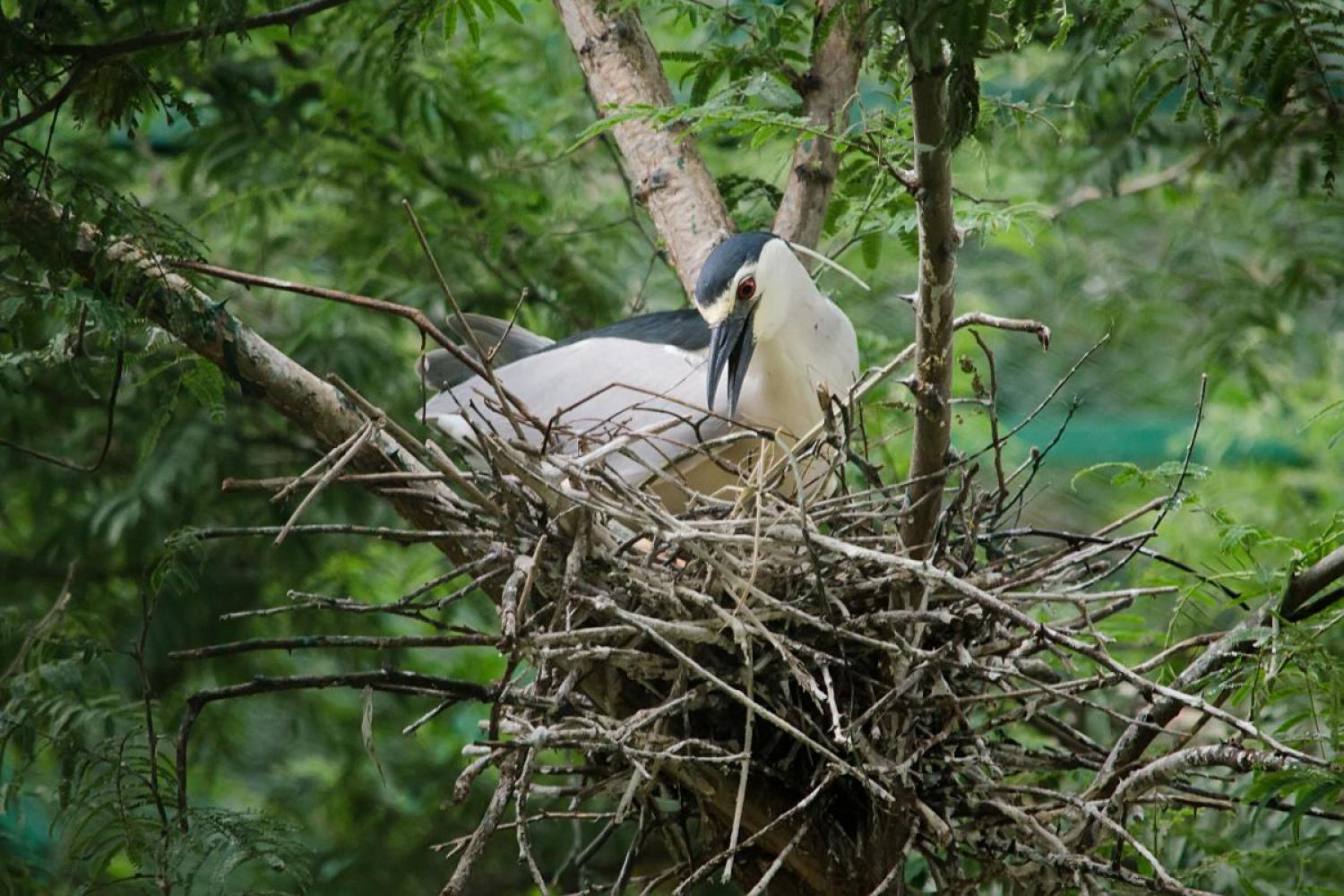Species of Thailand
Black-crowned night heron
Nycticorax nycticorax
Carolus Linnaeus, 1758
In Thai: นกแขวก
The black-crowned night heron (Nycticorax nycticorax), commonly abbreviated to just night heron in Eurasia, is a medium-sized heron found throughout a large part of the world, except in the coldest regions and Australasia (where it is replaced by the closely related rufous night heron, with which it has hybridized in the area of contact).
Description
Adults are approximately 64 cm long and weigh 800 g. They have a black crown and back with the remainder of the body white or grey, red eyes, and short yellow legs. They have pale grey wings and white under parts. Two or three long white plumes, erected in greeting and courtship displays, extend from the back of the head. The sexes are similar in appearance although the males are slightly larger. Black-crowned night herons do not fit the typical body form of the heron family. They are relatively stocky with shorter bills, legs, and necks than their more familiar cousins, the egrets and "day" herons. Their resting posture is normally somewhat hunched but when hunting they extend their necks and look more like other wading birds.
Immature birds have dull grey-brown plumage on their heads, wings, and backs, with numerous pale spots. Their underparts are paler and streaked with brown. The young birds have orange eyes and duller yellowish-green legs. They are very noisy birds in their nesting colonies, with calls that are commonly transcribed as quok or woc.
Distribution
The breeding habitat is fresh and salt-water wetlands throughout much of the world. The subspecies N. n. hoactli breeds in North and South America from Canada as far south as northern Argentina and Chile, N. n. obscurus in southernmost South America, N. n. falklandicus in the Falkland Islands, and the nominate race N. n. nycticorax in Europe, Asia and Africa. Black-crowned night herons nest in colonies on platforms of sticks in a group of trees, or on the ground in protected locations such as islands or reedbeds. Three to eight eggs are laid.
This heron is migratory in the northernmost part of its range, but otherwise resident (even in the cold Patagonia). The North American population winters in Mexico, the southern United States, Central America, and the West Indies, and the Old World birds winter in tropical Africa and southern Asia.
Behaviour
These birds stand still at the water's edge and wait to ambush prey, mainly at night or early morning. They primarily eat small fish, crustaceans, frogs, aquatic insects, small mammals, and small birds. During the day they rest in trees or bushes. N. n. hoactli is more gregarious outside the breeding season than the nominate race.
Parasites
A thorough study performed by J. Sitko and P. Heneberg in the Czech Republic in 1962–2013 suggested that the central European black-crowned night herons host 8 helminth species. The dominant species consisted of Neogryporhynchus cheilancristrotus (62% prevalence), Contracaecum microcephalum (55% prevalence) and Opistorchis longissimus (10% prevalence). The mean number of helminth species recorded per host individual reached 1.41. In Ukraine, other helminth species are often found in black-crowned night herons too, namely Echinochasmus beleocephalus, Echinochasmus ruficapensis, Clinostomum complanatum and Posthodiplostomum cuticola.
Etymology
The scientific name, Nycticorax, means "night raven", and refers to this species' nocturnal habits and harsh crow-like call.
In the Falkland Islands, the bird is called "quark", which is an onomatopoeia similar to its name in many other languages, like "kwak" in Dutch and Frisian, "kvakoš noční" in Czech, "квак" in Ukrainian, "кваква" in Russian, "vạc" in Vietnamese, "kowak-malam" in Indonesian, and "waqwa" in Quechua.
This article uses material from Wikipedia released under the Creative Commons Attribution-Share-Alike Licence 3.0. Eventual photos shown in this page may or may not be from Wikipedia, please see the license details for photos in photo by-lines.
Category / Seasonal Status
BCST Category: Recorded in an apparently wild state within the last 50 years
BCST Seasonal statuses:
- Resident or presumed resident
- Non-breeding visitor
Scientific classification
- Kingdom
- Animalia
- Phylum
- Chordata
- Class
- Aves
- Order
- Pelecaniformes
- Family
- Ardeidae
- Genus
- Nycticorax
- Species
- Nycticorax nycticorax
Common names
- Thai: นกแขวก
Conservation status

Least Concern (IUCN3.1)
Photos
Please help us review the bird photos if wrong ones are used. We can be reached via our contact us page.
Range Map

- Amphawa District, Samut Songkhram
- Ao Phang-Nga National Park
- Ban Laem District, Phetchaburi
- Bang Len District, Nakhon Pathom
- Bang Pa In District, Phra Nakhon Si Ayutthaya
- Bang Pahan District, Phra Nakhon Si Ayutthaya
- Bang Pakong District, Chachoengsao
- Bang Phra Non-Hunting Area
- Bang Pu Recreation Centre
- Bangkok Province
- Borabue District, Maha Sarakham
- Bueng Boraped Non-Hunting Area
- Chiang Dao District, Chiang Mai
- Chiang Khong District, Chiang Rai
- Chiang Saen District, Chiang Rai
- Doi Inthanon National Park
- Doi Lo District, Chiang Mai
- Doi Pha Hom Pok National Park
- Doi Saket District, Chiang Mai
- Doi Suthep - Pui National Park
- Doi Tao District, Chiang Mai
- Don Chedi District, Suphan Buri
- Hat Yai District, Songkhla
- Huai Chorakhe Mak Reservoir Non-Hunting Area
- Huai Sala Wildlife Sanctuary
- Kaeng Khoi District, Saraburi
- Kaeng Krachan District, Phetchaburi
- Kaeng Krachan National Park
- Kamphaeng Saen District, Nakhon Pathom
- Kantharawichai District, Maha Sarakham
- Khao Sam Roi Yot National Park
- Khao Sok National Park
- Khao Yai National Park
- Khao Yoi District, Phetchaburi
- Khlong Luang District, Pathum Thani
- Khon San District, Chaiyaphum
- Klaeng District, Rayong
- Ko Chang National Park
- Ko Samui District, Surat Thani
- Ko Sichang District, Chonburi
- Laem Pak Bia
- Mae Ai District, Chiang Mai
- Mae Mo District, Lampang
- Mae Rim District, Chiang Mai
- Mueang Chiang Mai District, Chiang Mai
- Mueang Chiang Rai District, Chiang Rai
- Mueang Chonburi District, Chonburi
- Mueang Kanchanaburi District, Kanchanaburi
- Mueang Khon Kaen District, Khon Kaen
- Mueang Krabi District, Krabi
- Mueang Lopburi District, Lopburi
- Mueang Nakhon Nayok District, Nakhon Nayok
- Mueang Nakhon Pathom District, Nakhon Pathom
- Mueang Nakhon Ratchasima District, Nakhon Ratchasima
- Mueang Nakhon Si Thammarat District, Nakhon Si Thammarat
- Mueang Nonthaburi District, Nonthaburi
- Mueang Pathum Thani District, Pathum Thani
- Mueang Pattani District, Pattani
- Mueang Phetchaburi District, Phetchaburi
- Mueang Phitsanulok District, Phitsanulok
- Mueang Samut Sakhon District, Samut Sakhon
- Mueang Samut Songkhram District, Samut Songkhram
- Mueang Sukhothai District, Sukhothai
- Mueang Suphanburi District, Suphan Buri
- Mueang Surat Thani District, Surat Thani
- Mueang Surin District, Surin
- Mueang Tak District, Tak
- Mueang Uttaradit District, Uttaradit
- Nong Bong Khai Non-Hunting Area
- Nong Prue District, Kanchanaburi
- Nong Song Hong District, Khon Kaen
- Nong Suea District, Pathum Thani
- Nong Waeng Non-Hunting Area
- Pa Sak Chonlasit Dam Non-Hunting Area
- Pai District, Mae Hong Son
- Pak Chong District, Nakhon Ratchasima
- Pak Kret District, Nonthaburi
- Pak Phli District, Nakhon Nayok
- Pak Thale
- Pak Tho District, Ratchaburi
- Pak Thong Chai District, Nakhon Ratchasima
- Pathio District, Chumphon
- Phaisali District, Nakhon Sawan
- Phan District, Chiang Rai
- Phanat Nikhom District, Chonburi
- Phi Phi Islands
- Phra Nakhon Si Ayutthaya District, Phra Nakhon Si Ayutthaya
- Phu Suan Sai National Park
- Phutthamonthon District, Nakhon Pathom
- Pran Buri Forest Park
- Sadeth Naikrom - Krom Luang Wildlife Sanctuary
- Sai Noi District, Nonthaburi
- Samut Prakan Province
- San Sai District, Chiang Mai
- Sanam Bin Reservoir Non-Hunting Area
- Sapphaya District, Chainat
- Si Racha District, Chonburi
- Si Satchanalai District, Sukhothai
- Sri Phang-nga National Park
- Taphan Hin District, Phichit
- Tarutao National Marine Park
- Tha Takiap District, Chachoengsao
- Tha Wung District, Lopburi
- Thale Noi Non-Hunting Area
- Thanyaburi District, Pathum Thani
- Thawat Buri District, Roi Et
- Wat Phai Lom & Wat Ampu Wararam Non-Hunting Area







